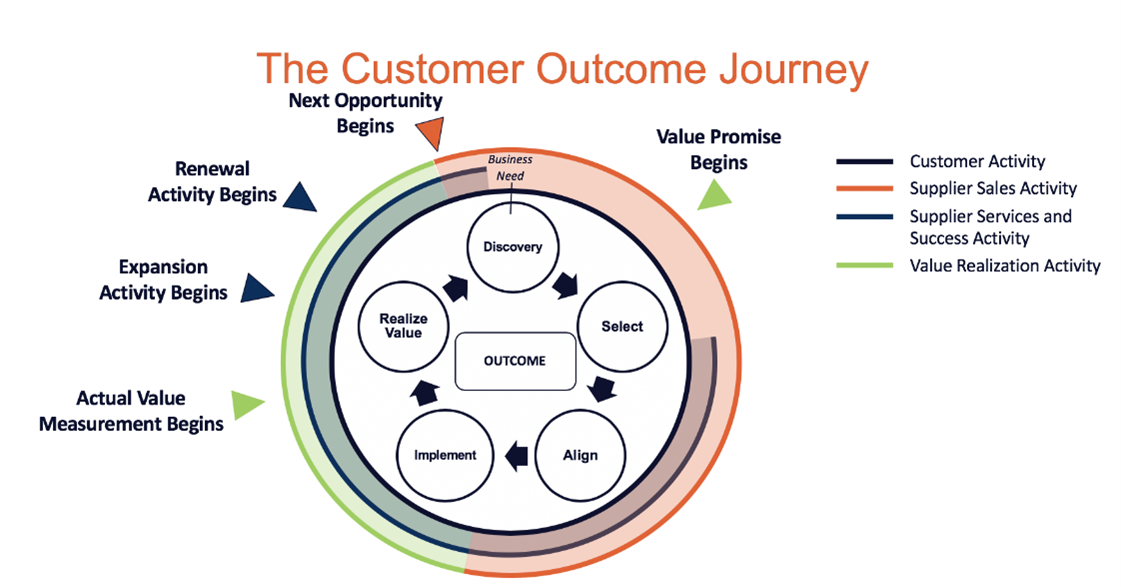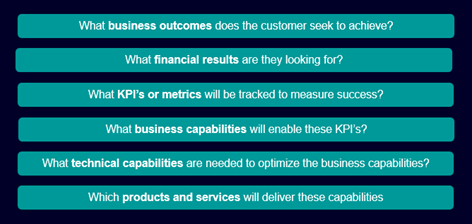Sink or swim: Outcome-based selling is non-negotiable with SaaS

The SaaS seismic shift
SaaS solutions have transformed the way we sell and consume software. Gone are the days of hefty upfront perpetual license deals and lucrative annual maintenance renewals. Shiny new features can no longer lure in customers. Now, it’s all about subscriptions, value, and, most importantly, delivering measurable customer business outcomes.
Customers call the shots
With SaaS selling, customers hold all the cards. They’re no longer willing to pay top dollar for software solutions sight unseen. Instead, they opt for subscription models, allowing them to pay as they go and jump ship if things don’t work out. This pressures us to continuously prove our worth by demonstrating that we deliver real, tangible value.
Customers’ command over their investments is not the only thing that is different. The decision-makers have changed too. These days, C-suite execs make purchasing choices, not just line managers. And guess what? They don’t care about nitty-gritty tech specs or product features and functions. They want to know how our solutions will help them achieve their business goals, streamline processes, and, ultimately, drive their organization forward.
Consumption conundrum
Software is no longer a one-and-done purchase—it’s sold on a consumption-based model where customers only pay for what they use. This requires us to demonstrate value month after month, year after year, consistently. If we fail to deliver the outcomes our customers seek, they’ll stop using our solutions, and the recurring revenue streams we depend on will dwindle. It’s a stark reality but one we need to tackle head-on.
The key to thriving is to focus relentlessly on customer success. We must be perceived as proactive business partners, constantly working with customers to understand their evolving needs, drive adoption and usage and, most importantly, help them achieve their desired business outcomes.
It’s no longer enough to sell software – we need to sell success.

The proof is in the pudding
Don’t just take my word for it. Industry experts agree that outcome-based selling is our new reality.
A recent article from Deloitte emphasizes that “providers gain a competitive advantage as they get an opportunity to differentiate themselves from the competition with products/services that can deliver a specific outcome expected by the customer. They can build stronger business relationships with their customers because of increased credibility and frequent business outcome-related interactions.”
Technology Services Industry Association’s (TSIA) research reinforces the importance of adopting an industry-specific outcome selling strategy. It found that companies that adopt outcome-based selling practices see win rates increase by 12%, average deal size go up by 7 and accelerate deal cycles by more than 10% compared to their peers. Companies effectively embracing this approach are leaving their feature-focused competitors in the dust when it comes to ARR growth.

Charting the course to customer success
So, how do you transition your team to adopt an outcome-selling approach? It starts with really understanding your customers – their pain points, business goals and priorities, and what success looks like for them.
Forrester recommends using frameworks like customer journey mapping and persona development to gain deeper buyer insights and tailoring your messaging and approach accordingly. This means going beyond surface-level demographics and firmographics and digging into the psychographics – the attitudes, aspirations and emotional triggers that drive decision-making.

By aligning your solutions to specific customer KPIs and business outcomes, you’ll have more strategic, value-driven conversations that position you as a trusted business advisor, not just a vendor. But to do this effectively, you must demonstrate deep industry expertise and a keen understanding of the unique challenges and opportunities within each vertical you serve.
These are the kinds of tangible, measurable outcomes that matter to customers. By identifying the key levers you pulled in those successful engagements, you can build a playbook for replicating that success with similar customers facing similar challenges.
One way to start thinking about outcomes is to reflect on past successes. Think about those deals where the customer was thrilled with the results they achieved with your solution. Did you help them streamline a critical process, saving them time and money? Did you help them increase revenue or market share? Did you help them mitigate risk or ensure compliance?
This is where collaboration across your organization becomes critical. By sharing these insights and successes across sales, customer success and other customer-facing roles, you start to weave outcome-based thinking into the fabric of your go-to-market strategy.
The art and science of selling outcomes
Outcome-based selling is equal parts art and science. It requires a blend of soft skills like empathy, active listening and storytelling, as well as hard skills like data analysis, business acumen and technical knowledge.
It’s about painting a compelling picture of what’s possible while also being grounded in the realities of what it takes to get there.
Most importantly, it’s about putting the customer at the center of everything you do. It’s about genuinely caring about their success and being willing to put skin in the game to help them achieve it.
Sink or swim
The writing is on the wall: outcome-based selling is no longer optional – it’s a must-have to survive. Customers demand it, and companies that embrace it reap the rewards.
Is it an easy shift? No. It requires a fundamental rewiring of your sales approach, a deep commitment to customer success, and a willingness to prioritize outcomes above all else. But the alternative is being left behind, watching as more customer-centric competitors swim laps around you.
The future belongs to those who don’t just sell software but sell success. Will you sink or swim?
Do you want to learn more about outcome-based selling? Watch our recent partner-exclusive webinar.
About the author
Bradley Stern oversees global partner sales development and leads the Siemens Xcelerator for Partner Excellence (XPE) program at Siemens Digital Industries Software. He has more than 10 years of sales and channel development experience with global technology providers.


